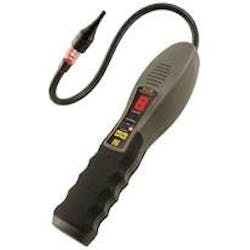General Tools & Instruments digital refrigerant leak detector certified to comply with new ASHRAE Standard
The Digital Refrigerant Leak Detector (RLD400) from General Tools & Instruments (General) has been certified by an accredited independent test laboratory to comply with the new American Society of Heating, Refrigerating and Air-Conditioning Engineers (ASHRAE) Halocarbon Refrigerant Leak Detector Standard 173-2012. The instrument has been certified at a leak rate of less than 1 gram per year.
The new Standard was published in December 2012 by ASHRAE to establish a method of testing for qualifying the performance of portable leak detectors designed for the detection of all CFC, HCFC, HFC, HFO and PFC halogenated refrigerant gases. The practices and procedures in this standard cover the testing of refrigerant leak detectors intended for use in the leak testing of refrigerating, air-conditioning and heat-pump systems and their components.
General's RLD400 is also certified to comply with SAE J2791, J2913 and J1627 standards, and the new European standard EN14624:2012. It is the only instrument of its kind to meet all five standards.
The RLD400 offers advanced detecting power and affordability. With its proprietary semiconductor sensor, this instrument is built to detect all commercially available HFC, HFO, HC, HCFC and CFC refrigerant gases, including many new ozone layer-friendly blends, such as R-22 and R-1234yf, approved under the EPA's Significant New Alternatives Policy (SNAP).
This tool, made in America, is ideal for inspecting and maintaining mobile and stationary air conditioners, refrigerators, chillers and heat pumps, as well as automotive and aviation A/C systems. The RLD400 effectively pinpoints leaks, providing these benefits:
- Prevents compressor, evaporator and condenser damage caused by air and moisture entering a system
- Saves money by precluding repeated system recharges and inefficient cooling operation
- Helps large system operators meet U.S. Clean Air Act leak repair timetable standards
- Inhibits further depletion of the ozone layer
Among the RLD400's best-in-class features are the lifespan of its proprietary semiconductor sensor—more than 300 hours of operation or 10 years normal use—and sensitivities of 0.05 oz./year (1.4 g/year) to R-134a and 0.025 oz./year (0.7g/year) to R-22. A true mechanical pump draws in samples, which increases sensitivity. Three sensitivity levels let users choose the right level for specific environments. Triple-redundant leak indication—a loud, fast beep; a bright flashing LED; and a relative digital leak size readout—make it easy to identify and characterize leaks in any setting. The RLD400's automatic calibration and reset ensures accurate leak readings not distorted by ambient levels. In addition, a leak test vial containing a refrigerant sample allows users to easily confirm the instrument is operating correctly. And with its durable construction and padded hard plastic carrying case, the RLD400 is built to survive punishing tasks and harsh environments.
